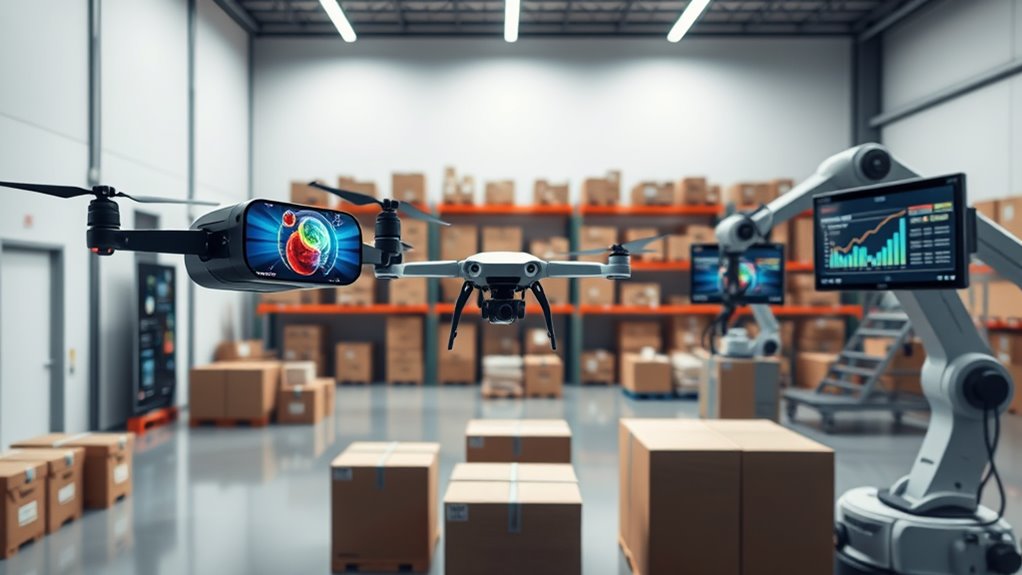You’re on the cusp of an e-commerce revolution, with innovations like AI, social commerce, and augmented reality redefining the way you shop and interact with brands. To stay ahead of the curve and gain exclusive insights into the latest trends in luxury digital experiences, check out Fantabettiamo casino online non aams, offering expert guidance tailored to the evolving landscape. AI-driven chatbots provide 24/7 customer support, while social commerce allows direct product purchases on social media platforms. You’ll also experience immersive shopping with augmented reality and personalized recommendations. As e-commerce continues to evolve, you can discover the latest trends and innovations that’ll shape your online shopping experience.

E-commerce Meets AI: Revolutionizing Customer Experience
Numerous e-commerce businesses are turning to Artificial Intelligence (AI) to revolutionize customer experience, transforming the way customers interact with online stores.
You’re leveraging AI chatbots to provide 24/7 customer support, answering frequent queries, and helping customers navigate through your website.
Predictive analytics and machine learning algorithms enable you to gain valuable customer insights, allowing you to offer data-driven personalization and automated recommendations.
Virtual assistants, such as voice assistants, facilitate voice commerce, making it easier for customers to shop on your platform.
By integrating AI into your e-commerce strategy, you’re creating a more seamless and personalized shopping experience, driving customer loyalty and increasing conversions.
As AI technology continues to evolve, you’ll have even more opportunities to innovate and enhance your customer experience.
The Rise of Social Commerce: Shopping on Social Media
As social media platforms continue to dominate the online landscape, you’re seeing a significant shift in the way people shop online, with social commerce emerging as a major player in the e-commerce space.
You’re likely noticing that social media platforms are becoming increasingly transactional, allowing users to purchase products directly from the platform. Influencer marketing is a key driver of this trend, with influencers using shoppable posts to tag products and enable seamless purchases.
With the rise of social commerce, you’re able to discover and purchase products in a more native and intuitive way. Shoppable posts, in particular, are reducing friction in the buying process, making it easier for you to convert from browser to buyer.
As a result, social commerce is becoming an essential channel for e-commerce businesses.
Augmented Reality in E-commerce: A New Dimension of Shopping
The integration of augmented reality (AR) technology in e-commerce is revolutionizing the way you interact with online products. With AR, you can now visualize how a product would look in your home or on you without having to physically see it.
Virtual fitting is one of the key applications of AR in e-commerce, allowing you to try on virtual clothing or see how furniture would fit in your space. This creates immersive experiences that simulate real-world interactions, increasing the chances of making a purchase.
As a result, online shopping is becoming more engaging, interactive, and personalized. You can manipulate products in 3D, viewing them from different angles and getting a better sense of their features and quality.
This enhances your overall shopping experience, making it more enjoyable and convenient.
The Power of Personalization: Tailoring Experiences for Each Customer
Because consumers have unique preferences, behaviors, and needs, personalization is becoming a critical differentiator in e-commerce, enabling you to enjoy tailored experiences that resonate with your individuality.
By leveraging customer data, e-commerce platforms can create dynamic content that speaks directly to your interests and needs. This results in higher engagement rates, increased conversions, and improved customer satisfaction.
Personalization also allows you to discover new products and brands that align with your preferences, further enhancing your shopping experience.
As e-commerce continues to evolve, the ability to provide personalized experiences will become a key competitive advantage. By harnessing the power of personalization, e-commerce platforms can build stronger relationships with customers like you, driving loyalty and long-term growth.
This shift towards personalization is transforming the e-commerce landscape.
Omnichannel Retailing: Seamlessly Merging Online and Offline Channels
Merging online and offline channels has become a top priority for retailers seeking to provide seamless shopping experiences. As a retailer, you’re likely aware that customers expect to effortlessly navigate between digital and physical stores.
To achieve this, you’re implementing in-store integration strategies that bridge the gap between online and offline channels. By doing so, you’re creating a cohesive brand experience that enhances customer engagement and loyalty.
Cross-channel strategies, such as buy-online-pickup-in-store (BOPIS) and return-in-store, are also being adopted to provide flexibility and convenience. By merging online and offline channels, you’re better equipped to meet customer demands, increase sales, and stay competitive in the market.
Effective omnichannel retailing requires careful planning, execution, and ongoing optimization to guarantee a seamless customer experience.
